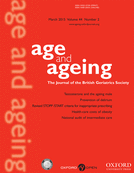-
PDF
- Split View
-
Views
-
Cite
Cite
A. J. Cruz-Jentoft, Y. Boirie, T. Cederholm, on behalf of the International Sarcopenia Initiative, Re: Issues concerning sarcopenia in ageing adults, Age and Ageing, Volume 44, Issue 2, March 2015, Pages 343–344, https://doi.org/10.1093/ageing/afu208
Close - Share Icon Share
Sir,
We appreciate the comments of Prof. Lesser to our complex systematic review on the prevalence and interventions of sarcopenia.
Our systematic reviewed tried to show the state of the art in this topic, and not to propose new methodologies not proposed by the authors of the primary studies, nor to deeply discuss methodological issues involved in the design of individual studies.
We fully agree that many problems persist unsolved in the field of measuring muscle mass. There is a common confusion between fat free mass and muscle mass (muscle is below 40% of fat free mass in older adults); a wide discussion on cut-off points that have to be used to define low muscle mass when defining sarcopenia [1, 2]; and sensitivity to change of muscle mass measurements using different techniques has not been properly assessed [3]. It is known that body weight masks changes in fat mass and fat free mass in elderly subjects [4], so fat free mass may not consistently reflect changes in muscle mass. This is particularly true in obese ageing individuals, as muscle may decrease together with liver or heart enlargement, resulting in a misleading stability in fat free mass.
However, we do believe that the concept of ‘primary age-related’ muscle mass loss has been confirmed in different longitudinal studies in aging and old humans using different methods to measure muscle mass, although it seems clear that muscle function and muscle quality impair more significantly than muscle mass, due to changes in muscle composition [5–8].
These and other problems in measuring muscle mass, together with the low predictive value of muscle mass for most outcomes lead to our groups and others to emphasise the role of muscle function upon the mass in the modern sarcopenia definitions [9, 10].
Longitudinal changes found in muscle mass and function in individual subjects would, of course, be relevant for clinical practice, as is true for most biological measures, but may not lead to a better understanding of sarcopenia as a condition.
Conflicts of interest
None declared.
To read more Letters or to respond to any Age and Ageing articles, please visit http://bit.ly/AALetters.




Comments